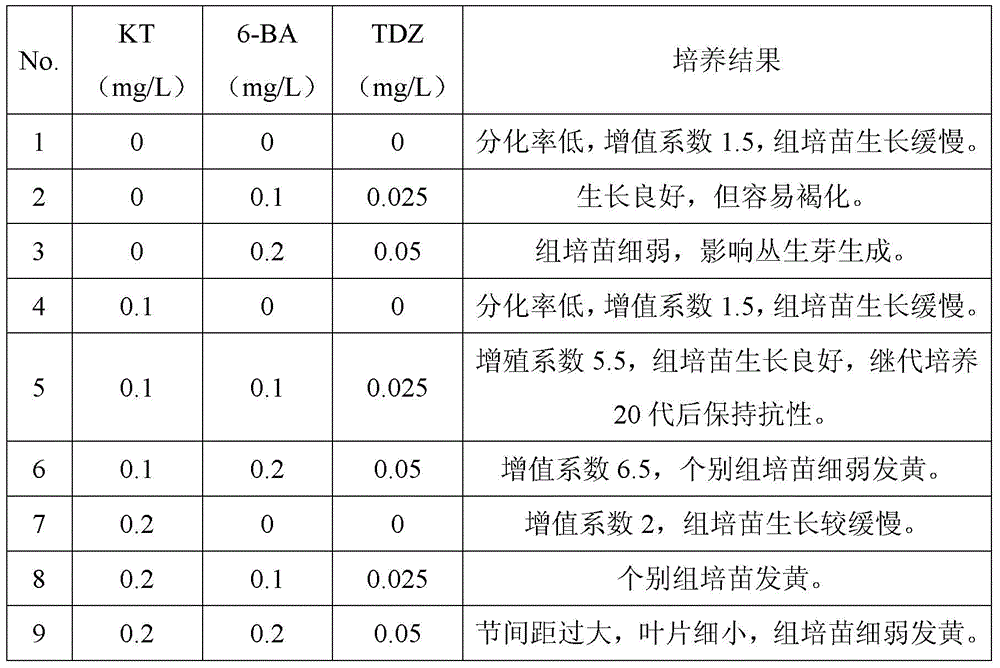A kind of subculture method of anti-rust black poplar tissue culture seedling
A subculture, rust-resistant technology, applied in horticultural methods, botanical equipment and methods, horticulture, etc., can solve the problems of easy lack of rust-resistant resistance, and achieve the effect of large-scale production
- Summary
- Abstract
- Description
- Claims
- Application Information
AI Technical Summary
Problems solved by technology
Method used
Image
Examples
specific Embodiment approach 1
[0011] Embodiment one: the subculture method of the anti-rust black poplar tissue culture seedling of the present embodiment, carry out according to the following steps:
[0012] 1. Screening of rust-resistant black poplar:
[0013] Separate fully expanded leaves with a leaf interval index of 5 to 9 from the dormant branches of 1-year-old black poplar in activation culture, take 8 to 12 leaves from each black poplar, inoculate with rust fungus, and then place the inoculated leaves at 16°C In the growth room of the black poplar, carry out 16h light every day, continue to cultivate for 7 days, calculate the disease index of each black poplar, select the black poplar plant with the disease index<25, clean and disinfect the black poplar leaves, inoculate into 1 black poplar containing 300mg / LAmp On the / 2MS solid medium, carry out subculturing for 20 days, screen out the black poplar plants with disease index<25 after subculturing for 20 days as rust-resistant black poplar;
[00...
specific Embodiment approach 2
[0017] Specific embodiment two: the difference between this embodiment and specific embodiment one is that: the method for inoculating rust bacteria in step one is: suspending spores with a Tween 20 aqueous solution of 0.004% with a mass percent concentration, and then spraying inoculation, wherein the concentration of spores 40000 / mL. Others are the same as in the first embodiment.
specific Embodiment approach 3
[0018] Specific embodiment three: the difference between this embodiment and specific embodiment one or two is: the calculation method of disease index is: disease index=100 * ∑ (number of sick leaves at all levels * representative value at all levels) / (investigation total leaf number × the highest level representative value), the disease index <25 means disease resistance, 25 < disease index <50 means moderate disease resistance, 50 < disease index <75 means susceptible disease, and 75 < disease index means highly susceptible disease; among them, the disease level and The representative values of each level are as follows: level 1 without erythrosporium on the leaves, with a representative value of 0; level 2 with uredospores on the area below 1 / 4 of the leaves, with a representative value of 1; 1 / 4 to 1 / 2 of the area of the leaves If there are uredospores produced, it is grade 3, with a representative value of 2; if 1 / 2 to 3 / 4 of the leaf area has uredospores produced, it...
PUM
 Login to View More
Login to View More Abstract
Description
Claims
Application Information
 Login to View More
Login to View More - R&D
- Intellectual Property
- Life Sciences
- Materials
- Tech Scout
- Unparalleled Data Quality
- Higher Quality Content
- 60% Fewer Hallucinations
Browse by: Latest US Patents, China's latest patents, Technical Efficacy Thesaurus, Application Domain, Technology Topic, Popular Technical Reports.
© 2025 PatSnap. All rights reserved.Legal|Privacy policy|Modern Slavery Act Transparency Statement|Sitemap|About US| Contact US: help@patsnap.com

